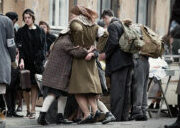
In WW2 when the German Governor of Warsaw in Occupied Poland the city into three areas : one for Germans. another for Poles, and the third for Jews, the infamous Ghetto was born.. It was October 1940 and because the Nazis had also been rounding up all the Jews in surrounding areas, the initial population was as large as 450,000.
 The Germans closed the Warsaw Ghetto to the outside world with a 10′ high wall which was topped with barbed wire. Initially escapees were imprisoned but that soon changed and they were shot on sight. If that wasn’t evil enough, the Germans undertook a massive propaganda campaign and was manipulating the image of the Jews as filthy lice-infested spreaders of typhus to justify to the outside World why they needed to be captured and controlled.
The Germans closed the Warsaw Ghetto to the outside world with a 10′ high wall which was topped with barbed wire. Initially escapees were imprisoned but that soon changed and they were shot on sight. If that wasn’t evil enough, the Germans undertook a massive propaganda campaign and was manipulating the image of the Jews as filthy lice-infested spreaders of typhus to justify to the outside World why they needed to be captured and controlled.
One of the first Ghetto residents was Emanuel Ringelblum a historian who specialized in Jewish life when the Nazis invaded Poland in 1939. He had set up an Agency to help the constant intake of refugees, but more importantly he had grasped the historical significance of what was happening, and he was determined that one day the world should really know the reality of the horrors which so quickly turned into genocide.
This docu-drama from filmmaker Roberta Grossman is Ringelblum’s story of how he began keeping a diary of exactly of what he saw unfolding around him . To help him with the project he assembled a group of talented people that include artists, writers and intellectuals and insisted that they do the same.
 He insisted that their first hand accounts should accurately reflect day to day life and include any ephemera like posters, food labels, family photos and even Nazi Orders. It all had to be done in the utmost secrecy as anyone caught with anything criticizing the Nazis could be shot on spot. So only he and Hersz Wasser his second in command knew where the growing archive was being stored,, so if any of the group , known as Oyneg Shabbos were captured and tortured by the Gestapo, they could not reveal the whereabouts of the archive,
He insisted that their first hand accounts should accurately reflect day to day life and include any ephemera like posters, food labels, family photos and even Nazi Orders. It all had to be done in the utmost secrecy as anyone caught with anything criticizing the Nazis could be shot on spot. So only he and Hersz Wasser his second in command knew where the growing archive was being stored,, so if any of the group , known as Oyneg Shabbos were captured and tortured by the Gestapo, they could not reveal the whereabouts of the archive,
Grossman’s script was based on Ringelblum’s archive also on Samuel Kassow’s book (which gave this movie thie name, and also from the memoirs of Israeli Journalist Rachel Auerbach, one of just two survivors of the group of writers. Grossman recreated some of the scenes with actors partly as narration but also to help to put a human dimension on the unthinkable horrors
The Nazis razed the Ghetto to the ground in 1945 after the inhabitants, who hadn’t been transported off to the Concentration Camps, and who against impossible odds caused an Uprising. It cost Ringleblum and his wife and young child their lives, and by then some 300,00 Jews had been murdered, and a further 92000 had starved to death on the streets of the Ghetto.
Who Will Write Our History is a powerful and extremely sobering story that is probably not as well known as it should be. The role of Oyneg Shabbos in working with Ringleblum can certainly never be underestimated on so many levels and Grossman’s compelling film ensures that another generation (or two) will remember their bravery and sheer commitment to share the truth.
N.B. The movie is now available on major streaming platforms such as Itunes and Amazon Prime

